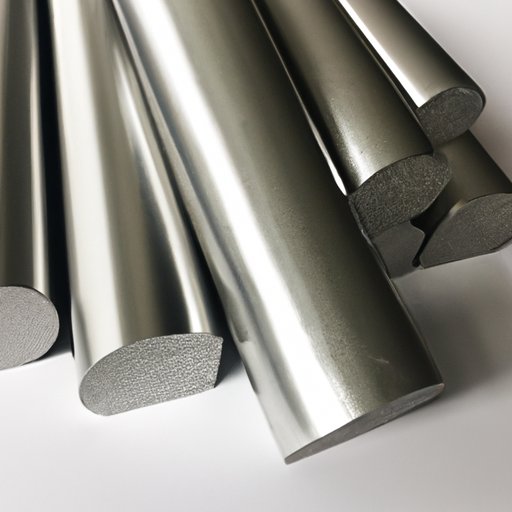Introduction
Aluminum is one of the most abundant elements in the Earth’s crust, making up 8% of its mass. As a metal, it has many desirable characteristics that have made it a popular choice for a wide variety of applications. In this article, we will explore the physical properties of aluminum and how they differ from other metals.
How Aluminum Differs from Other Metals
Aluminum exhibits several unique properties that make it an attractive material for many uses. One of its most important features is its strength. Aluminum is strong yet lightweight, which makes it ideal for applications where weight and strength are both important considerations. Additionally, aluminum is highly resistant to corrosion, meaning it can withstand exposure to harsh environments without deteriorating.
Aluminum is also a good conductor of heat and electricity. Its high thermal conductivity means that it can easily transfer heat away from an object, while its high electrical conductivity means that it can be used to transmit electrical signals. These properties make aluminum an ideal choice for use in electronics, heat exchangers, and other applications.
Types of Physical Properties for Aluminum
When discussing the physical properties of aluminum, there are several key terms that should be understood. The first is tensile strength, which is the maximum amount of stress that a material can withstand before breaking. Yield strength is similar, but it refers to the amount of force required to deform a material permanently. Elasticity refers to a material’s ability to return to its original shape after being stretched or compressed, while ductility is a measure of how much a material can be deformed without breaking.
Examining the Strength of Aluminum
Aluminum is much lighter than steel, but it is still relatively strong. When compared to other metals, aluminum has a tensile strength of about 69 MPa (megapascals). This is significantly lower than steel, which has a tensile strength of around 400 MPa. However, aluminum is much more malleable than steel, meaning it can be bent and formed into a variety of shapes with relative ease.
The strength of aluminum can be tested using a variety of methods. Common testing methods include tensile testing, impact testing, and fatigue testing. Each method measures different aspects of the material’s strength and provides valuable information about its performance under various conditions.
Corrosion Resistance in Aluminum
Aluminum is highly resistant to corrosion, which is why it is often used in outdoor applications. Corrosion is caused by the presence of oxygen, moisture, and other chemicals in the environment. Aluminum forms a protective oxide layer on its surface when exposed to these elements, which prevents further corrosion.
There are several strategies for preventing corrosion in aluminum. One of the most effective is galvanizing, which involves coating the metal in zinc. This creates a barrier between the aluminum and the elements, protecting it from corrosion. Additionally, proper maintenance and cleaning can help reduce the risk of corrosion.

Understanding Thermal Conductivity in Aluminum
Thermal conductivity is a measure of how well a material transfers heat. Aluminum has a high thermal conductivity, meaning it can easily transfer heat away from an object. This property makes it an ideal choice for use in heat exchangers, cooking utensils, and other applications.
Heat transfer occurs through three mechanisms: conduction, convection, and radiation. Conduction is the transfer of heat through direct contact, while convection is the transfer of heat through fluids. Radiation is the transfer of heat through electromagnetic waves. Measuring the thermal conductivity of a material can help determine how efficiently it transfers heat.

Examining the Electrical Conductivity of Aluminum
Aluminum is an excellent conductor of electricity, meaning it can be used to transmit electrical signals. Compared to other metals, aluminum has a higher electrical conductivity, which makes it a popular choice for wiring and other electrical applications. However, it also has some drawbacks. For example, aluminum is more prone to oxidation than copper, which can lead to increased resistance and reduced efficiency.

Exploring the Recyclability of Aluminum
Aluminum is one of the most widely recycled materials in the world. This is because it is easy to melt down and reform into new shapes and products. Recycling aluminum reduces the amount of energy and resources needed to produce new aluminum, making it an environmentally friendly option.
However, recycling aluminum presents some challenges. For example, it requires specialized equipment and processes, and it can be difficult to separate aluminum from other materials. Additionally, aluminum can be contaminated with other substances, which can reduce its quality.
Conclusion
In conclusion, aluminum is a versatile metal with many desirable physical properties. Its strength, corrosion resistance, thermal conductivity, electrical conductivity, and recyclability make it an ideal choice for a wide range of applications. Understanding the physical properties of aluminum can help you make informed decisions when selecting materials for your projects.

